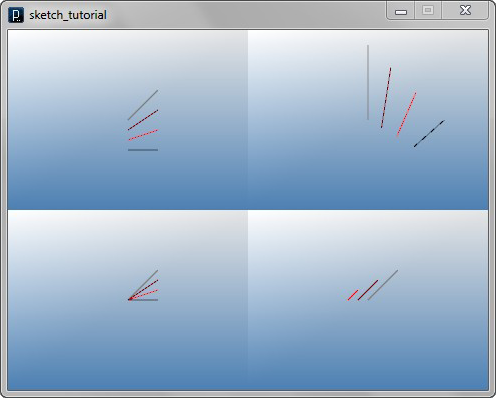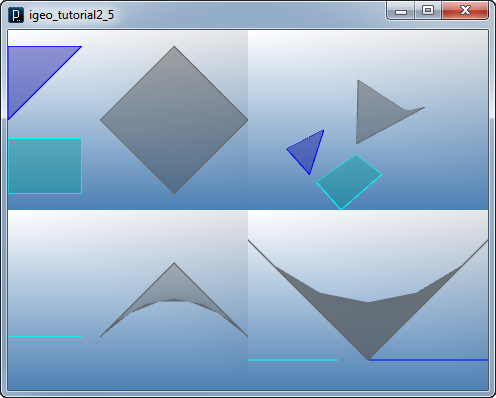

 Python Tutorials Python Tutorials | (back to the list of tutorials) |
 Creating Points
Creating Points
![]()
![]()
![]()
![]()
add_library('igeo')
size( 480, 360, IG.GL )
IPoint(0,0,0)
IPoint(20,0,0)
IPoint(20,20,0)
IPoint(0,20,0)

 Setting Color of Objects
Setting Color of Objects![]()
![]()
![]()
![]()
add_library('igeo')
size( 480, 360, IG.GL )
IPoint(0,0,0).clr(255,0,0) # RGB in int
IPoint(20,0,0).clr(0,0.3,0.9) # RGB in float or double
IPoint(20,20,0).hsb(0.5,1.0,0.9) # HSB in float or double
IPoint(0,20,0).clr(255) # grayscale in int, float or double

 Creating Lines
Creating Lines![]()
![]()
![]()
![]()
add_library('igeo')
size( 480, 360, IG.GL )
ICurve(0,0,0, 30,30,30)
ICurve(0,-10,0, 30,10,20).clr(0.5,0,0)
ICurve(0,-20,0, 30,-10,10).clr(1.0,0,0) # NOTE: float is put in clr()
ICurve(0,-30,0, 30,-30,0).clr(1,0,0) # NOTE: int is put in clr() and the range of int in color is 0-255

 Creating NURBS Curves
Creating NURBS Curves![]()
![]()
![]()
![]()
add_library('igeo')
size( 480, 360, IG.GL )
controlPoints1 = [[0,0,0], [20,20,20], [-20,20,0]]
ICurve(controlPoints1, 2) # degree = 2
# to put number inside
ICurve([[0,15,0], [20,35,20], [-20,35,0]], 2).clr(1.,0,0)
# degree 1 curve (polyline)
controlPoints2 = [[-60,-30,0], [-60,-10,0], [-40,-30,0], [-40,-10,0]]
ICurve(controlPoints2, 1).clr(0,1.,1.)
# or you can omit the degree argument for polyline
controlPoints3 = [[-30,-30,0], [-30,-10,0], [-10,-30,0], [-10,-10,0]]
ICurve(controlPoints3).clr(0,0.5,1.)
# degree 2 curve
controlPoints4 = [[0,-30,0], [0,-10,0], [20,-30,0], [20,-10,0]]
ICurve(controlPoints4,2).clr(.5,0,1.)
# degree 3 curve
controlPoints5 = [[30,-30,0], [30,-10,0], [50,-30,0], [50,-10,0]]
ICurve(controlPoints5,3).clr(1.,0,1.)

 Creating Simple Surfaces
Creating Simple Surfaces![]()
![]()
![]()
![]()
add_library('igeo')
size( 480, 360, IG.GL )
ISurface(0,0,0, 40,40,40, 80,0,0, 40,-40,40)
# 3 corner points (triangle)
ISurface(-50,40,0, -10,40,0, -50,0,0).clr(0,0,1.)
# rectangle
ISurface(-50,-10,0, -10,-10,0, -10,-40,0, -50,-40,0).clr(0,1.,1.)

 Creating NURBS Surfaces
Creating NURBS Surfaces![]()
![]()
![]()
![]()
add_library('igeo')
size( 480, 360, IG.GL )
# 4 points in u direction, 3 points in v direction
controlPoints = \
[[[-30,-30, 10], [-30, 0,-20], [-30, 30, 0]], \
[[ 0,-30,-10], [ 0, 20,-50], [ 0, 30,-20]], \
[[ 30,-30,-20], [ 30, 20, 60], [ 30, 30, 30]], \
[[ 60,-30, 0], [ 60, 0, 40], [ 60, 30, 30]]]
# u degree = 3, v degree = 2
ISurface(controlPoints, 3, 2).clr(1,.8,0)

 HOME
HOME
 FOR PROCESSING
FOR PROCESSING
 DOWNLOAD
DOWNLOAD
 DOCUMENTS
DOCUMENTS
 TUTORIALS (Java /
Python)
TUTORIALS (Java /
Python)
 GALLERY
GALLERY
 SOURCE CODE(GitHub)
SOURCE CODE(GitHub)
 PRIVACY POLICY
PRIVACY POLICY
 ABOUT/CONTACT
ABOUT/CONTACT
